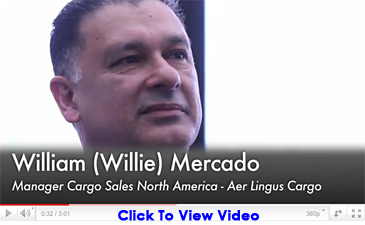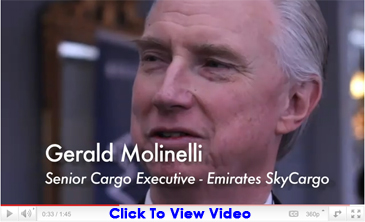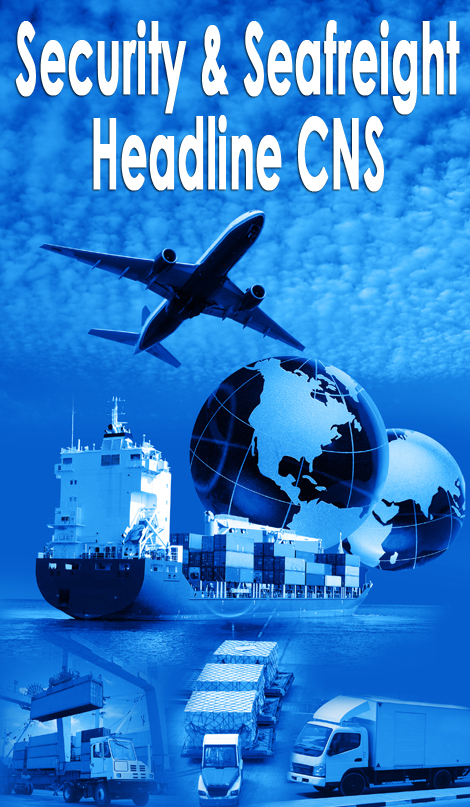 Exclusive
From CNS Partnership Conference 2011 Phoenix Arizona— Exclusive
From CNS Partnership Conference 2011 Phoenix Arizona—
Michael Vorwerk, the CNS President opened this year’s conference
sounding a bit like the late comedian Rodney Dangerfield, who made a
living saying that he got “no respect”.
But in Michael’s world the words
were directed as he put it at insufficient worldwide focus on logistics.
Mr. Vorwerk now commanding his second
annual CNS Partnership gathering added an early morning challenge for
all the conferees at the gathering to strive for a better understanding
of what the industry does and not only vis-à-vis regulators but
also the public at large.
“At issue are continued economic
volatility driven especially by high fuel prices,” he said adding,”
we need to increase business confidence which brings about growth in
air cargo”.
Mick Fountain, the CNS advisory board
chairman added his welcome, citing some CNS achievements since last
year’s meeting, including 10 new carriers participating in the
CASS program, improved processes which resulted in reduced CASS re-billings
and savings of $300,000 in CASS operations due to the implementation
of a new system by CITI. He recognized Delta Cargo in particular for
its efforts on Cargo2000.
The first keynote speaker, Steve Gunning, managing director International
Airlines Groups comprised of BA and IB cargo emphasized the role and
benefits of air cargo as a key enabler to world trade.
At the same time he lamented the 4.9%
drop in rates for cargo over the past 40 years, evidently a steady trend.
Steve questioned whether the industry had the
adequate infrastructure to handle the projected, albeit modest, cargo
growth efficiently. Here e-freight and Cargo2000 were mentioned as needing
a major collective push to rise beyond the paltry 1% growth.
His recipe for success for the industry
was to act jointly – where legal – a now perennial nod to
the antitrust watchdogs, improve the industry’s profile, standardize
processes and interact with regulators, agencies and governments with
one voice through GACAG.

Michael Vorwerk
|

Mick Fountain
|

Kevin Sterling
|
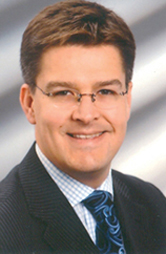
Michael Schaecher
|
Industry consolidation continues, and
here the BA/IB and UA/CO examples were brought up, with resulting benefits
to customers and the offering of greater networks.
The BA/IB cargo exceutive echoed Michael’s
emphasis on standardization and the need to modernize processes.
In response to a question regarding the
BA/IB cargo link up, as to what surprised him, Steve mentioned the quality
of IB IT and yields higher than BA as well as the lack of a common off
the shelf revenue management solution for the two airlines.
The forwarder perspective was delivered
by Michael Schaecher, DHL’s head of global airfreight.
Picking up on the opening theme, Mr. Schaecher
highlighted the need to raise the awareness of air cargo stressing the
value it brings the consumer.
The executive noted that airlines can
do more to educate the public through ubiquitous in-flight magazines
by including information about cargo and its positive contribution,
such as disaster relief.
Conferees learned that the rallying cry
based on the DHL experience focuses on quality management rather than
airline specific.
Redundant messaging added cost and it’s
a common occurrence. Information was processed late and there’s
a need to integrate data in operational systems. XML ought to be adopted
as the messaging standard, together with RFID and a push for regulations
to allow its deployment in aircraft. IATA in general and CASS in particular
were accused of being “ignorant of local markets and people”
because of centralized operations.
External factors in terms of both challenges
and opportunities exist because of globalization. Europe sees a big
push for carbon efficiency with targets as ambitious as a 10% reduction
by 2012 and 30% by 2020 were points touched by the DHL executive.
As the day moved on U.S. trade implications
was the title of Kevin Sterling’s speech.
Mr. Sterling is an equity research analyst,
transportation services with BB&T, a financial institution.
Some of the highlights from a blizzard
of of statistics in this presentation addressed the impact of 6.4% of
all U.S. imports coming from Japan in the aftermath of the recent catastrophic
earthquake and tsunami. 35% of industry capacity was carried using narrow
body aircraft. Mr. Sterling noted that the aircraft conversion market
most recently has seen almost no activity.
Hong Kong surpassed Memphis as the largest
cargo airport.
Airfreight growth depended on heavy industrial
production rather than GDP.
The second keynote of the morning featured
William Flynn, president and CEO of Atlas Air Worldwide Holdings, in
this position since 2006.
Looking at global trends, the ACMI executive
noted that the 10 year cargo forecast was an increase of 4.5% per annum,
with Asia set to double in the course of 2010 to 2019.
Going green, was raised by Mr. Flynn,
as he pointed out that an example of fresh produce from Africa to the
UK alone which supported the livelihood of 1.5 million people while
producing less CO2 than similar produce grown in the UK, despite the
cost of transportation was an illustration of "airfreight being
a key factor in efficient access to markets, a catalyst to international
trade which drives competition and innovation.”
Another factoid to drive this point home
was that driving 6.5 miles for shopping emits more carbon than flying
a pack of beans from Kenya to the UK.
“The path to sustainable air cargo
as practiced at Atlas is to balance the cost and benefits through a
thoughtful approach and engagement at multiple levels.”
Lunch was sponsored by American Airlines
Cargo and just before breaking for lunch, a short video drove home the
increasing role of social media for businesses.
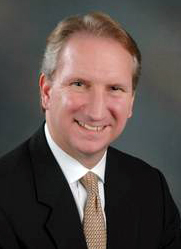  The
afternoon program continued with a departure from the norm, and a first
for CNS in the form of a presentation by Otto Schacht, (right) head
of global seafreigtht, Kuehne & Nagel and Gene Seroka, (left) president
the Americas, NOL Group, a steamship line. The
afternoon program continued with a departure from the norm, and a first
for CNS in the form of a presentation by Otto Schacht, (right) head
of global seafreigtht, Kuehne & Nagel and Gene Seroka, (left) president
the Americas, NOL Group, a steamship line.
Seafreight shares some of the problems
with airfreight, with some historical differences – from 1980
where steamship lines had a 90% share and forwarders 10% market share
to 2010, where the carriers had 60% and forwarders the remainder.
A major achievement and successful streamlining
for seafreight was the carrier-owned portal INTTRA for EDI.
However, airfreight with CASS was ahead
of seafreight where payments are still largely manual.
Statistics for the number of containers
by trade lane pointed to a fivefold increase in the Asia to Europe traffic
over a period of about 30 years. Carbon footprint was an issue both
from an environmental perspective but also as a result of high fuel
prices.
We learned that steamship lines resorted
to “slow steaming” a reduction in speed of up to 50% and
this would continue for the foreseeable future.
The CCWG, a joint shipper and carrier
group works on clean cargo initiatives.
Gene Seroka addressed the fact that “slow
steaming” causes a shortage of containers because of longer transit
times.
On the bright side new cargo liners were
being built by companies such as Maersk that reduce emissions by 50%.
The see-saw effect of pricing which determined
when and whether freight moved from air to ocean and vice-versa and
capacity issues were among additional similarities.
David Hoppin, supply chain strategist
analyst gave the industry outlook using a variety of data sources, including
IATA and Boeing.
The data indicated that contrary to popular
belief, price/speed trade-offs have not changed significantly over the
past 20 years.
What was changing was the shipper’s
ability to plan, reduce the number of emergencies to account for an
estimated 50% of airfreight. Although there are signs of recovery, whether
the industry can resume historical growth rates remains an unanswered
question.
Sustained higher energy prices however
are driving changed sourcing patterns and these stand to influence how
and where growth will occur.
The closing session at this most end-to-end
session day at CNS Phoenix dealt with Air Cargo Security after Yemen
by Todd Owen, executive director, cargo & conveyance security, U.S.
Customs and Border Protection. This session covered essentially developments
we reported after the CNS mini conference in Washington last February;
the express carriers’ program which boasted in excess of 635,000
shipments successfully processed for advance cargo data.
Conferees learned that the forwarder/passenger
airline combination was being worked on next, to be followed by work
on solutions for mail. Hard timelines were not in place at this stage
with continued focus on global cargo programs for more effective overseas
screening, avoiding redundant screening, “trusted shipper”
programs and a commitment to improve scanning technologies so that screening
is commensurate with the risk.
The close joint work of CBP and TSA was
seen as a positive accomplishment which has benefited the industry.
Ted Braun
|



 The
afternoon program continued with a departure from the norm, and a first
for CNS in the form of a presentation by Otto Schacht, (right) head
of global seafreigtht, Kuehne & Nagel and Gene Seroka, (left) president
the Americas, NOL Group, a steamship line.
The
afternoon program continued with a departure from the norm, and a first
for CNS in the form of a presentation by Otto Schacht, (right) head
of global seafreigtht, Kuehne & Nagel and Gene Seroka, (left) president
the Americas, NOL Group, a steamship line. 

